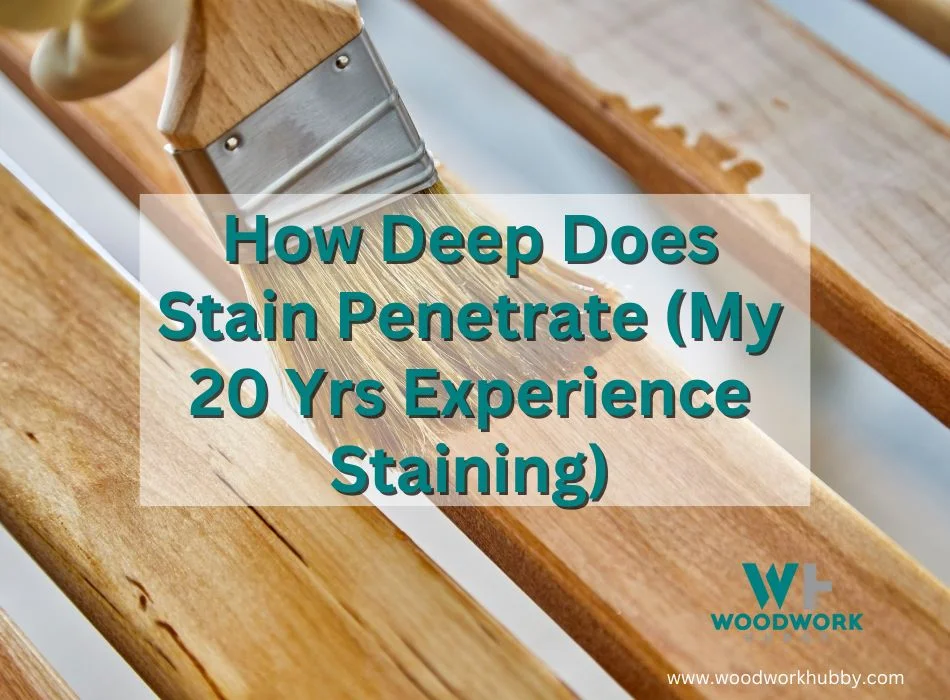Wood staining is surface-relevant for most people as its aesthetic visibility is the highest on the surface. But when it comes to beautifying wood’s cross-section, how deep does stain penetrate, becomes quite relevant.
Stain penetrates wood up to 1/4 inch (6.35 mm) at a minimum and 1.5 inches (38.1 mm) at a maximum. The depth of penetration is dictated by the stain viscosity, the wood’s porousness, and the environment. By altering these factors in your favor, you can make the stain penetrate deeper into the wood.
In this article, you will learn everything I’ve discovered about stain penetration over 20 years of woodworking. This includes how you can improve stain depth (both hue and penetration) and which type of cloth will work best for wiping.
Among other things, you will also discover what kind of stain penetrates the deepest.
Does Stain Penetrate Wood?
Stain penetrates wood, unlike paint, which forms a film on top of the wood surface. This can result in a resilient tint. Soaking also means that the wood grain is more visible, and the natural beauty of the wood texture gets highlighted.
Wood stain’s penetrative capacity is generally consistent, but the wood it is applied to can vary in its porousness. That is why you might notice that in some instances, a stain penetrates 1.5 inches (38.1 mm) past the surface, while in others, it fairs to cross a 1/4-inch(6.35 mm) barrier.
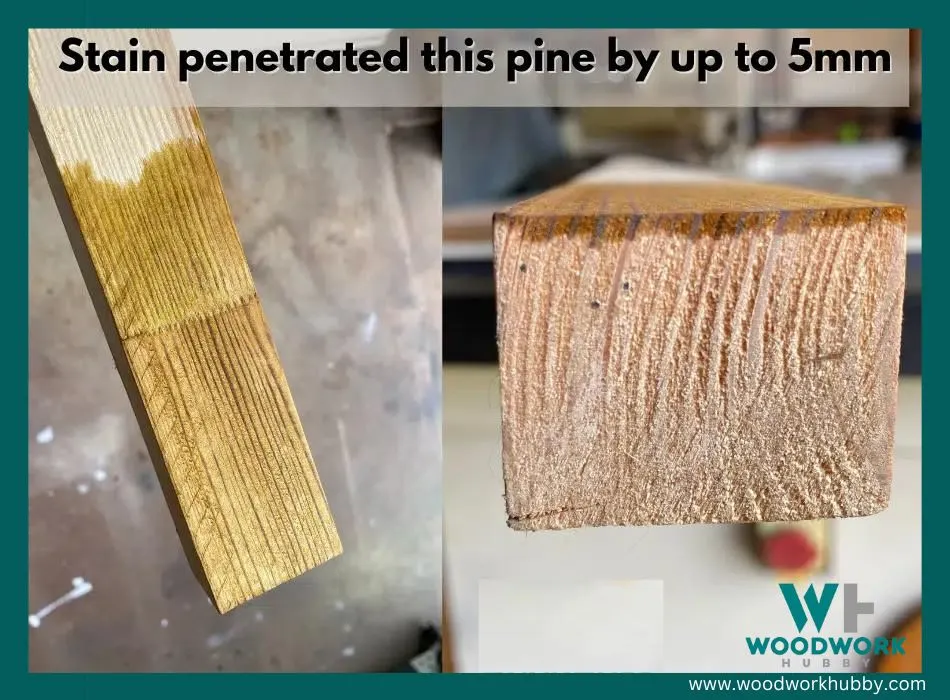
It is easy to erroneously associate a stain’s penetrative capacity with the type of stain you use. While it is true that some stains penetrate deeper than others, the material that they are applied to matters just as much as the stain itself.
Another factor that affects how deep a stain coat seeps into wood is the environmental condition. To demonstrate how the environment dictates stain penetration, we have to use an example of a cup.
Let’s suppose you have a 1-ounce (28.41 mL) shot glass. You can pour one ounce of stain into it. But if half of the glass is already filled with water, you cannot pour as much stain into it.
Something similar happens to wood but with moisture. The pores of wood can be viewed as microscopic cups. Moisture in the environment gets absorbed by wood. The more moisture the wood absorbs, the less capacity it has to soak up the stain.
Another way the environment affects staining depth is by altering stain viscosity. The term viscosity refers to “runniness.” The runnier a stain is, the more it penetrates wood. A thick stain is too bulky to get into wood pores.
If we return to the example of liquid being poured into a shot glass, you can see that a big chunk of ice might not get into the glass. However, liquid glass easily gets in. Wood pores have openings like the glass. However, these openings taper off with depth.
The wood pores have their greatest wideness at the surface and shut off completely towards the core. The runnier the stain is, the deeper it can afford to venture into these pores. No matter how viscous it gets, though, it can rarely penetrate past 2 inches (50.8 mm).
How Do You Make Stain Penetrate Deeper?
A video showing how you make stains penetrate deeper.
To make a stain penetrate deeper into the wood, you need to ensure that the wood pores are open and that the wood is dry. Moreover, you must sufficiently saturate the surface with stain. Heat is another factor that can help make the stain go past the taper-off point of the pores.
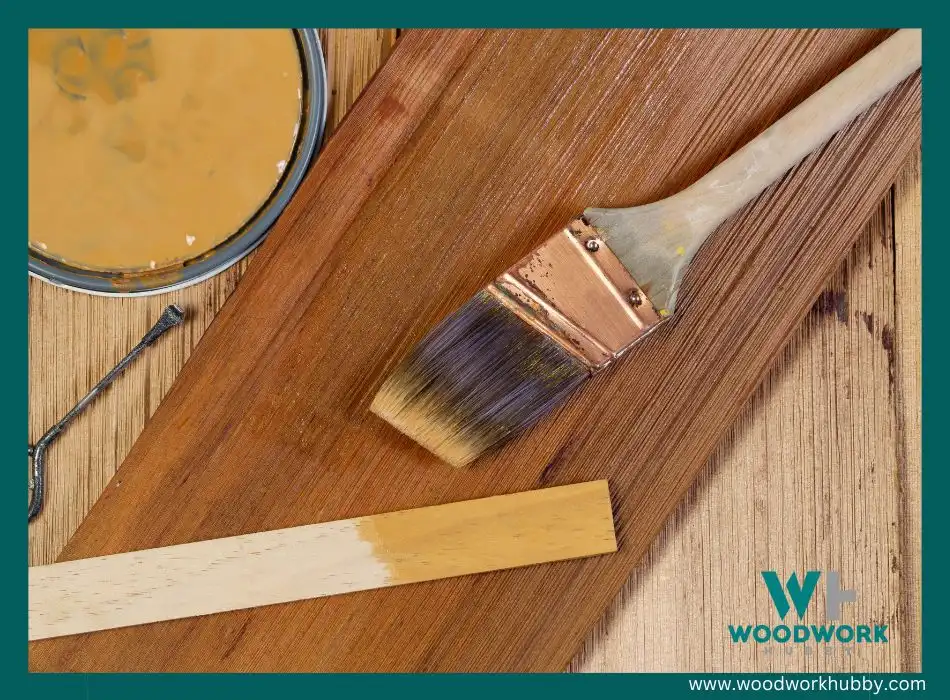
Sand the Wood
Sometimes a wood board might be pre-finished or coated with a clear varnish. This would make it harder for stain or any other liquid to penetrate deeper into the wood. In other instances, the wood pores are naturally shut at the top. In either case, sanding the wood can open up the pores and support stain soaking.
Work With Dry Wood
While many resources suggest using moist wood to get a bulk of the stain to dry at the top, it is counter-intuitive to the stain depth. To make the stain go further in wood, it must be applied to dry wood. The drier the lumber, the more room there is for the stain to venture into.
Then the Stain
The final thing you can do to make the stain go further is to make it runny. There are two ways to make wood stain runnier. The first is to apply it in a hot working temperature.
The second is to use a thinner to make the stain, well, thinner! I prefer the thinner method simply because the hot working environment affects the drying time of the stain, and I don’t want premature drawing even as a remote possibility.
It is worth noting that a wood stain’s darkness is affected by factors other than how deep it goes into the wood. Yes, the depth of absorption affects how much of it shows on the surface. However, the depth of the hue doesn’t increase with stain absorption.
Note: Deeper stain doesn’t always get the deepest hue
To get a deeper stain hue, you need to ensure that there is a sufficient stain at the top of the wood surface. You can do this in a few ways. A dirty wipe that smears the stain on the top layer before it can run deeper into the wood is one method of achieving this. Another is to work with wood that is pre-saturated with moisture or stain.
The final way to get a darker hue is to keep coating the top layer with more stain until it is concentrated enough around the surface. All of these work to make the stain appear deeper.
To make the stain penetrate deep and appear deep in hue at the surface, you can use only one strategy. The steps to it are as follows:
- Sand the wood surface – This opens up the wood pores.
- Thin a portion of the stain – Using thinner helps a part of the stain to soak up the deeper layers of wood.
- Soak the wood in stain – Once the interior is soaked with a thin stain, you can use proper stain to soak up the surface.
- Apply pure stain to the wood as it begins to dry – This is the stage where you get to use the part of the stain that you haven’t thinned for deeper saturation
- Let the stain dry and wipe – This step is as is standard for regular staining.
How Long Should the Stain Penetrate Before Wiping?
A video showing how to stain wood and five things you should never do.
If you have previously worked with epoxy, paint, or even tung oil, you might have very different expectations of drying time. Wood stain doesn’t take as long to dry. It takes 5 to 15 minutes before it is dry enough to wipe.
You should wait 5 minutes to let the thin stain seep into the wood and 15 minutes to let the thick stain penetrate before you can wipe it with a soft cloth. Make sure you don’t get rough with the wiping, as wipe marks can show on the wood surface.
Best Clothes to Wipe Stain
The cloth you use to wipe the stain after it has sufficiently seeped into the wood is supposed to be soft. The goal is to spread the rest over the surface without pulling the stain from the pores by being too harsh.
Absorbent clothes work really well. You might use a microfiber cloth, but that would not be a very sound use of money. The following products offer a better value for money.
Sceng Cheesecloth
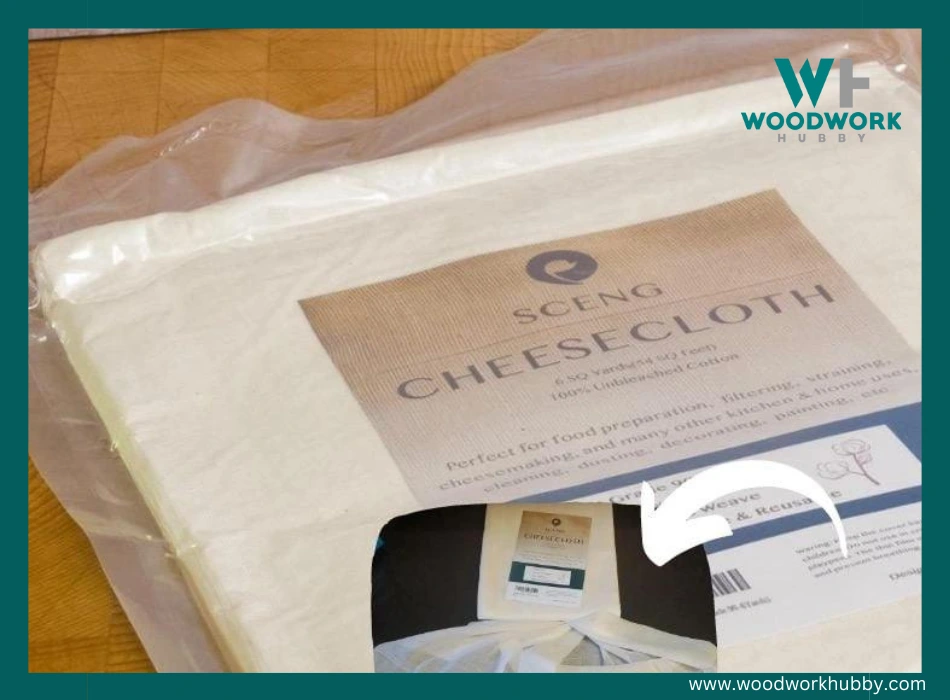
Unbleached cheesecloth is one of the best soft fabrics to use for wiping stains across a porous wooden surface. The Sceng Cheesecloth is a Grade 90 cheesecloth with an excellent reusability factor. Plenty of single-use cheesecloths exist but having one that can be washed and reused is better for the average woodworker.
Cheesecloth, Grade 90, 36 Sq Feet
This product has accumulated over 6,900 reviews and ratings that collectively add up to an average of 4.7 stars on a 5-star scale. Its specific ratings for aspects like quality of material, ease of use, and durability are rated 4.8 stars.
MaKRS Stain Pad
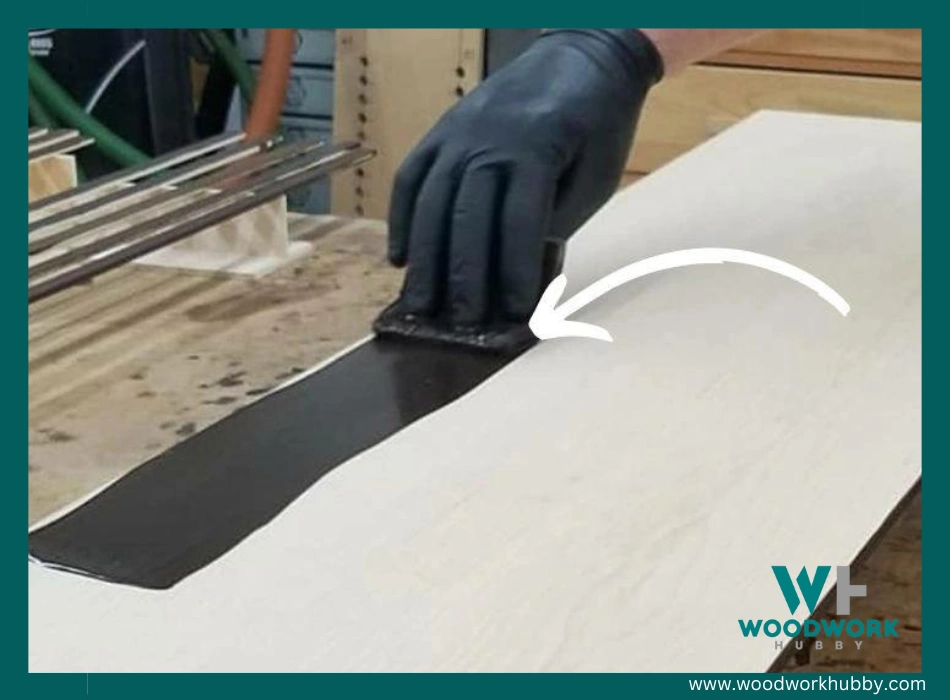
If you’re not sure about using alternative fabrics like glass-cleaning soft sheets and cheesecloths, you might as well get a product specifically formulated to wipe the stain on the wood.
MaKRS Stain Pad
MaKRS stain pad is designed to give a streak-free and lint-free wiping experience. It comes in 12 to 16 applicators, which means you can use the package a few times. But unlike a washable cheesecloth, this product has an upper limit on how often you can use it. That’s why its overall 4.3/5-stars rating is not matched by its 2.8-star value-for-money rating.
Which Stain Penetrates Deepest Into Wood?
Oil-based stains penetrate the deepest into wood because they take a long time to dry and can be applied in a hot working environment. This ensures that the oil goes to the deepest possible level beyond the wood surface.
In this section, we will go over a few stains that have an admirable penetration rate on average wood surfaces.
- Minwax Oil-Based Wood Stain – This oil-based stain comes in a broad range of finish options. With over 42 choices in how you want the wood to look post-staining, you have a lot of freedom of preference. More importantly, this product’s main selling point is that it is a penetrating stain. The manufacturer, a trusted brand among woodworkers, puts its reputation on the line, positioning this product as a “deep penetrating” wood stain. Check out my blog about staining birch plywood to look like walnut to learn more.
- Penofin Deep Penetrating Oil Treatment – This oil treatment has great penetrative potential because of its rosewood oil content. It has a 4.7-star rating on a 5-star scale, and it offers ultraviolet light protection.
Final Thoughts – How Deep Does Wood Stain Penetrate?
Stain penetrates as deep into the wood as it can, which depends on the wood pores and its presaturation. In most cases, the stain goes 1/4 to 1.25 inches (6.35 mm to 31.75 mm) past the wood surface. Sanding the wood and using an oil stain can result in decent penetration.

